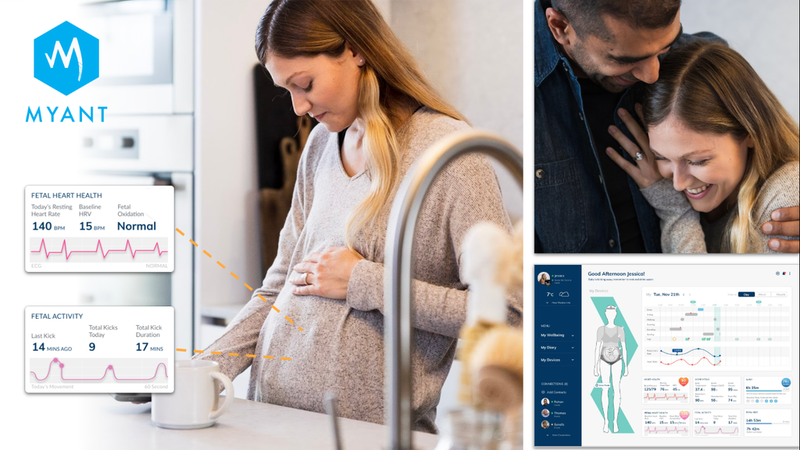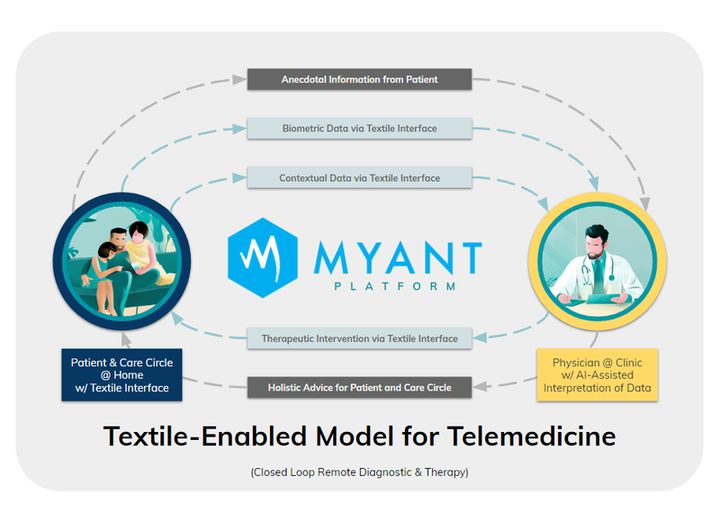
Tony Chahine, Founder and CEO of Myant
Myant
Bringing
Diagnostic Power to
Undergarments
By knitting sensors and actuators with conductive yarn to create a textile computing platform, Myant strives to make underwear the hottest new diagnostic device.
By Stephanie Kreml,
MD
What do undergarments have to do with cardiac monitoring? If it’s up to Myant, cardiologists may use undergarments, including bras, underwear, and undershirts to perform diagnostic studies in the near future.
The Toronto-based company is developing a platform with sensors and conductive materials to create textiles for a variety of applications including remote monitoring, rehabilitation, and telemedicine. Myant showcased their vision of the future for these applications in January at the 2020 Consumer Electronics Show.
Myant is currently seeking FDA 510(k) clearance for its Skiin line of Connected Innerwear. The company makes these undergarments by knitting textile-based sensors directly into the fabric with conductive yarn. A small module slips into a pocket of the undergarment’s band and houses the device’s electronics and batteries. Battery life is comparable to a cell phone, “and can be recharged on schedule similar to your phone to minimize habit change,” says Tony Chahine, founder and CEO of Myant.
To develop clinical applications including cardiac monitoring, Chahine points out, “we already have a partnership with the Mayo Clinic which grants us exclusive access to their AFib detection algorithms for textile-based applications.”
Myant’s textile computing platform also integrates actuators into fabric in addition to sensors. Chahine explains, “Myant creates textiles that are bidirectional interfaces to the human body — in other words, we can measure the heart’s activity but also communicate back with electrical stimuli.”
“We are always interested in what others are doing in terms of wearable defibrillators, and we have been working with our partners at ZOLL Medical in the space for a few years,” he continues. Myant’s technology would enable the production of a more elegant and form-fitting garment for patients who are not candidates for implantable defibrillators or are awaiting cardiac transplant.
And this may help with patient compliance. Chahine observes, “Textiles sit right up against the skin, your largest organ that serves as the gateway to your body, and we interact with textile without having to think about interacting with textile.”
“To that end, garments in the Skiin line are knitted to look and feel exactly like your everyday clothing. The garments are machine-washable and dryer friendly like you would expect from everyday clothing because, frankly, this is everyday clothing.” Chahine states, “We are trying to create the most frictionless experience possible.”

Experienced Partners
We wanted to challenge the world to rethink textiles, something that ALL of us have interacted with 24/7 over the last few thousand years.
Chahine explains, “Underwear is a very natural form factor to start with because it is worn by practically everyone across society, regardless of age or ability.” And underwear is usually worn snuggly against the skin which allows good electrical contact for sensors.
“Of course, certain form factors are better at capturing the electrical activity of the heart than others,” Chahine adds. “By providing different form factors (i.e. bra, underwear, shirt, etc.) we simplify the method of capturing ECG to putting on clothes while increasing the likelihood of obtaining the highest quality data from the torso.”
Using undergarments as the scaffold for sensors allows precise placement for improved quality data capture. “The various form factor possibilities also allow for different vectors to be measured, yielding better and comprehensive information about the heart’s electrical activity,” Chahine points out.
However, Myant is aware that consumer choice may come into play when making decisions about wearing garments as diagnostic devices. “If you don’t want to wear the shirt we designed, maybe you can wear a shirt made by one of our partners that is ‘powered by Skiin.’”
Why Underwear?

The various form factor possibilities also allow for different vectors to be measured, yielding better and comprehensive information about the heart’s electrical activity.

Myant has been working to develop textiles that can sense the electrical activity of the heart, and deploying these textiles in different form factors (i.e. clothing, furniture, car seats, etc.).
Inspired by the Need for Connection
Tony Chahine founded Myant to develop products to address the questions he had when dealing with his father’s dementia. He wondered, “How does one feel connected to another person who may lack the ability to convey how they feel? How does one connect to another person who may lack the ability (either physically or cognitively) to use the digital tools that the able-bodied adult populations can use?”
So in addition to creating a platform for wellness and remote patient monitoring, Chahine’s long-term goal for Myant is to provide a platform for caregivers to take care of their parents and loved ones. “When communities were more physically connected, the burden of care was shared. … Today, with the way communities are more geographically dispersed, the same quality of connectedness is just not possible,” says Chahine. “To that end, we want to enable you to digitally check in on your loved ones with a quick glance, in the same way you would quickly peer over at your elderly father sitting in the other room to assess his state.”
Challenges Completed
Looking back at the road to Myant’s success, Chahine notes that “creating this diverse interdisciplinary team, providing a common language for all of them to interact, and then integrating all the different parts has been the greatest challenge. It’s a challenge that has taken us a decade to overcome.” Now Myant is on the verge of a breakout year.
The company has an 80,000 square foot manufacturing facility using state-of-the-art 3D robotic knitting machines made by Myant’s technology partner STOLL. And once the Skiin line of Connected Innerware receives FDA clearance, users and clinicians will be able to capture continuous ECG recordings, heart rate, heart rate variability, respiration rate, posture detection, and fall detection, depending on the form factor used.
“Connected textiles along with the Myant Platform, which houses the machine learning [algorithms] and distributes the data, will work together to democratize access to electrocardiography and generally better heart health outcomes for all,” says Chahine.
The Time of Textiles
Myant continues to research other clinical applications. Practitioners could also use its bidirectional interfaces for rehabilitation after stroke with functional electrical stimulation or transcutaneous electrical nerve stimulation for pain management.
And to progressively improve the quality of its sensor interfaces, Myant partnered with Heraeus, a medical device materials company. The partnership will investigate ways to integrate Heraeus’ Tecticoat coating for electrophysiology applications.
Looking beyond garments, Chahine sees applications throughout the home and office. “When Myant looks at that chair, we don’t see a chair, we see an opportunity to measure ECG, to manage stress, to identify who you are and adjust your micro-environment to optimize comfort, anticipate potential workplace health and safety concerns, sustainably manage heating and energy, and so much more.”
Chahine asserts, “We wanted to challenge the world to rethink textiles, something that ALL of us have interacted with 24/7 over the last few thousand years.” And with its new products, Myant will do just that.
Myant has been applying its unique expertise in the development of textiles that can sense and react to the human body to create solutions that help close the feedback loop between patients and healthcare practitioners. Myant’s solution consists of textile form factors (from everyday clothes to specialized medical garments) that can sense and respond to the human body, as well as a digital platform that employs machine learning that uses the data to deliver relevant insights back to the patient, their healthcare practitioners, and loved ones who care for and support the patient’s wellbeing.
Myant is ushering in a model for heart health management that is continuous, ambient, preventative, and democratized. This will create continuous access to best-in-class heart health machine learning algorithms, something that is currently confined to leading hospitals and cardiologists.
Leading healthcare experts like Dr. Suraj Kapa, a cardiologist and medical innovation expert from the Mayo Clinic who advises on healthcare strategy for Myant, agree on the potential for textile to transform the way care is delivered and managed. “Scaling access to medical diagnostics will be necessary to improve global health – novel tools and technologies like wearable textiles holds the potential value to democratize healthcare in a way that has never previously been imagined,” notes Dr. Kapa.
Enabling Access to Heart Health Management for All via Everyday Clothing
